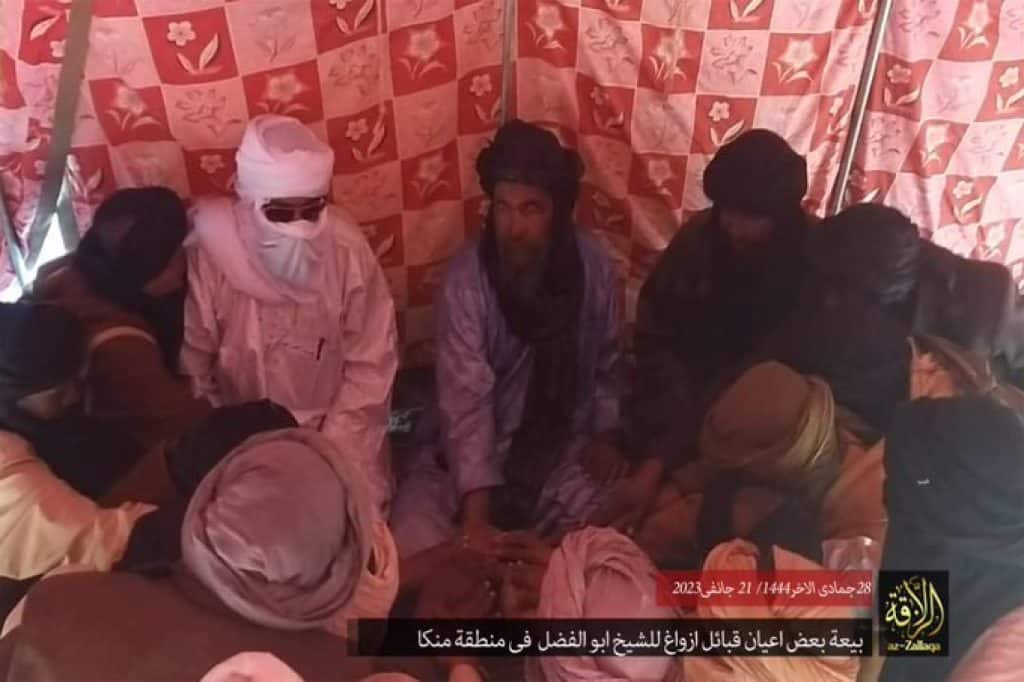
Over the weekend, the Group for Support of Islam and Muslims (JNIM), al Qaeda’s branch in the Sahel and much of West Africa, published photos showing several notables from various local clans in northern Mali pledging bay’ah [allegiance] to its leader, Iyad Ag Ghaly.
The bay’ah ceremony in Mali’s extreme northern Menaka Region comes after intense clashes between various local factions and communities, sometimes backed by JNIM, and the Islamic State’s Sahel Province (more colloquially known as the Islamic State Greater Sahara, or ISGS).
In defending local communities, JNIM has now benefited from many such factions joining its ranks for protection.
Despite only a handful of photos being released, several images do show the clan notables sitting with Iyad Ag Ghaly and pledging loyalty to him. In other photos, JNIM’s men can be seen accepting the pledge from several armed men, including some in technicals (or pick-ups fitted with heavy machine guns).
As of the time of publishing, no video or audio has been publicly released from these events.
According to Radio France Internationale (RFI), the clan notables belonged to the Daoussahak community near the northern Malian town of Inékar, close to the borders with Niger. Though commonly referred to as a sub-section of the Tuareg due to common cultural and linguistic traits, the Daoussahak maintain they are an independent ethnic group in Mali’s north and predate many of the Tuareg in the area.
The Daoussahak comprise one of the main factions of the Movement for the Salvation of Azawad (MSA), an ostensibly pro-government militia in the north. It is likely that many of the armed men seen in JNIM’s photos were once members of the MSA-Daoussahak (MSA-D), though MSA-D has denied any recent defections to JNIM.
Though the MSA contains two main factions of MSA-D and MSA-Chamanamas (or MSA-C, named after a local Tuareg confederation in the area), only the MSA-D has fought against the Islamic State in the past. It has fought the Islamic State alongside another pro-government militia in the area, the Imghad Tuareg and Allies Self-Defense Movement (GATIA).
Early last year, the GATIA-MSA alliance fought a brutal battle against the Islamic State’s men in Menaka, which left hundreds of civilians dead. These clashes continued throughout 2022 with many more dying last October, while the United Nations reported almost half a million people in Mali’s northern regions of Gao and Menaka were displaced from this fighting.
A month later, the Islamic State upped its campaign against the GATIA-MSA alliance and especially JNIM by claiming a series of attacks against the factions in the Menaka Region. Photos released by the Islamic State at the time showed dozens of killed GATIA, MSA, and JNIM fighters across several battles.
In response to growing Islamic State activity, JNIM has invested more in its presence and messaging in Menaka. In addition to moving more men into the area, the al Qaeda branch also publicly appealed to locals to assist it in its fight against the Islamic State.
For instance, in a statement released in early November, it stated “we call on all Muslims to stand up to these extremists and those who helped them.” Though it is unclear how many, if any, factions or people took up JNIM call to arms at the time.
However, it is evident that the group was portraying itself as both a partner and a defensive force to the locals bearing the brunt of the Islamic State’s violence. In an area wherein state presence, or that of the MINUSMA, the UN’s peacekeeping force, is very limited, such an offer by JNIM to provide this protection was likely not taken lightly by the locals of Menaka.
Portraying itself as a community defender is a common tactic for JNIM across Mali and one it has perfected in central Mali, where it also maintains a significant presence.
It remains to be seen if this bay’ah ceremony was a one-off event or the start of a new trend in Mali’s extreme north. What is clear, however, is that appealing to locals and attempting to fill voids and vacuums left by the lack of state presence continues to be a standard modus operandi for al Qaeda’s various branches.
Note: Article originally stated the MSA-C also fought the Islamic State, though it has not reported any such clashes. Article updated to correct the inaccuracy.







